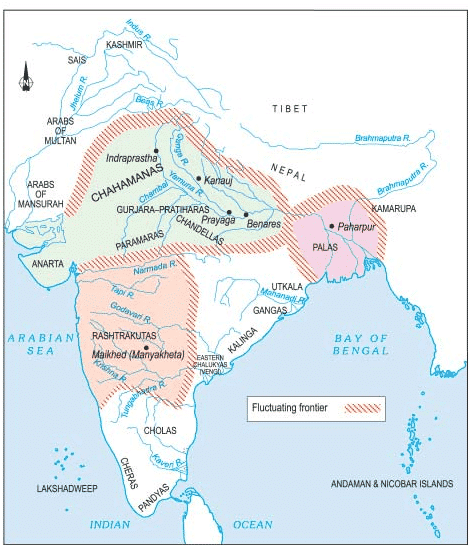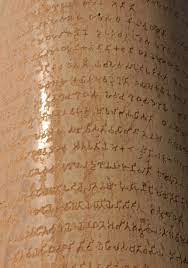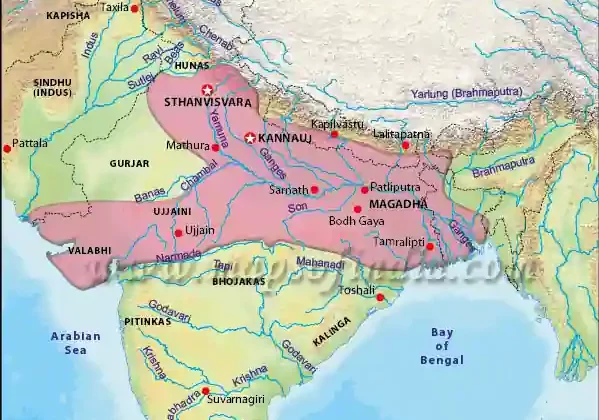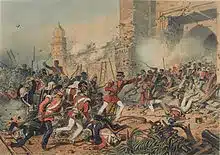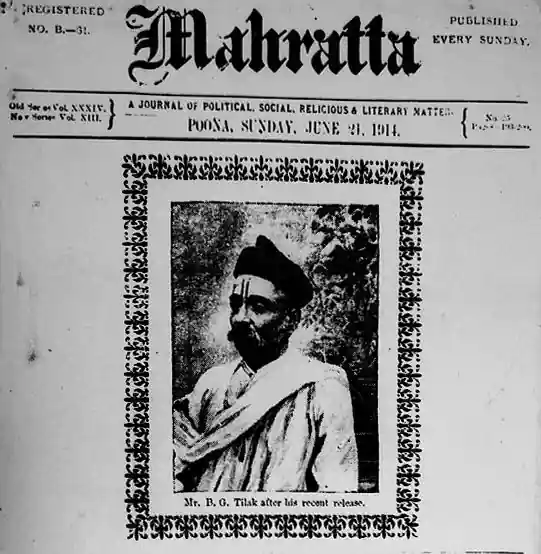Introduction of the Gupta Period
- The Guptas are believed to be feudatories of the Kushans.
- They are most likely Vaishyas in origin, and they ruled over fertile parts of the madhyadesha, that is, anuganga (the middle Gangetic basin), saketa (modern Ayodhya, Uttar Pradesh), and magadha (mostly Bihar).
- The Guptas could easily exploit the iron ore deposits of central India and southern Bihar, and also took advantage of their proximity to the areas of north India which carried on silk trade with the Byzantine empire (Eastern Roman empire).
- ‘Garuda’ was probably their state seal.
Sources of the Gupta Period
INSCRIPTIONS
- Allahabad Prashasti (eulogy) talks about the greatness of Samudragupta as an administrator and as a great conqueror who waged 100 battles. The king, Srigupta, has been identified as the first Gupta king mentioned in the Allahabad pillar inscription.
- Mehrauli Iron Pillar Inscription – It talks about the greatness of Chandragupta Vikramaditya II and his victory against the Sakas.
- Eran Copper Plate Inscription, found in Allahabad was issued by Bhanugupta. It is the first written recorded evidence on the custom of Sati.
NUMISMATICS
- The Guptas issued silver coins on the model of the Kushans. In the coins of Samudragupta, he is shown fighting with lions and playing harp (Veena-like musical instrument).
- Chandragupta I, in his silver coins is found depicted along with his wife, Kumaradevi. In the coins of Chandragupta Vikramaditya II, the signs depicting Aswamedha are found.
LITERATURE:
- Literature is an important source to construct the history of Guptas.
- Kalidas wrote the famous Avignanashakuntalam, Meghasandeshan, Ritusamharam, Kumarasabhavam, Raghuvansam, Malavikaagnitram. In his writings, the Gupta society is reflected.
- Vajjika wrote Kaumudimohotsavam. It is a description about Chandragupta I coming to power.
- Visakhadutta wrote Devichandraguptam which talks about Chandragupta II coming to throne after killing his brother Ramagupta and marrying his sister-in-law, Druvadevi.
- Sudraka wrote Mrichyakatikam meaning ‘Clay doll’.
- Bhasa wrote Vasavadatta, a play on the urban life under the Guptas.
- Meetakshara written by Vigneshwara, deals with social law and customs of the time and is most important in the context of inheritance issues. It still forms the basis of many Indian Laws.
- Neetisara written by Kamandaka, also deals with law and is popular as The Arthashastra of the Guptas.
Other Sources:
- I-tsing, a Chineses traveler, came to India between A.D. 671 and 695. He mentioned Srigupta as the builder of a temple at Gaya for the Chinese pilgrims about 500 years before his time.
- Puranas also mentioned that the early Guptas controlled the area along the Ganga (the middle Gangetic basin), Prayag (Allahabad and surrounding region), Saketa (Ayodhya region), and Magadha.
Why Is The Gupta Period Called The Golden Age Of India?
The polity of the Gupta Period
A brief about the kings of the Gupta dynasty is given in the table below:
| Gupta Dynasty Kings | Facts about Gupta Kings |
| Sri Gupta | Founder of Gupta Dynasty Reign from 240 CE to 280 CE Used the title of ‘Maharaja‘ |
| Ghatotkacha | Son of Sri Gupta Reign from 280-319 CE Took the title of ‘Maharaja‘ |
| Chandragupta I | Reigned from 319 CE to 335/336 CE Started the Gupta Era in 320 CE. He assumed the title of ‘Maharajadhiraja‘ Married Lichchavi princess Kumaradevi |
| Samudragupta | Reigned from 335/336 CE to 375 CE Called ‘Napolean of India’ by V.A. Smith (Irish Indologist and Art Historian) |
| Chandragupta II | Reigned from 376-413/415 CE Navratnas (9 Gems in his Court) Took the title ‘Vikramaditya’ |
| Kumaragupta I | Reigned from 415 CE to 455 CE Founded Nalanda University He was also called Shakraditya |
| Skandagupta | Reigned from 455 AD – 467 AD Was a ‘Vaishnavite‘ Son of Kumaragupta Repulsed an attack by the Hunas but this strained his empire’s coffers |
| Vishnugupta | Last known ruler of the Gupta Dynasty (540 AD – 550 AD) |
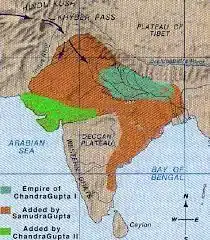
Chandragupta – I ( c. 320–335/336 CE)
- Chandragupta-I succeeded his father Ghatottotkacha.
- Chandragupta-I was considered to have laid the foundation of the great Gupta Empire. He was married to a Lichchhavi princess Kumaradevi.
- The Gupta era was started with the coronation of Chandragupta-I in A.D. 320. He was the first Gupta king to adopt the title ‘Maharajadhiraja’ and issued gold coins.
- The Lichchhavis were an old and established Ganarajya and quite powerful and still being respected in north India.
- The marriage alliance of Chandragupta-I was important for his political career as is proved by the coins Chandragupta I. These coins portray the figures of Chandragupta and Kumaradevi with the name of the Lichchhavis.
- In the Allahabad inscription, Samudragupta son of Chandragupta-I and Kumaradevi, proudly called himself Lichchhavis ‘Dauhitra’ i.e. son of the daughter of Lichchhavis.
- His empire included parts of modern Bihar, Uttar Pradesh and Bengal; with its capital was at Pataliputra.
Samudragupta (c.335/336–375 CE)
- Samudragupta succeeded his father Chandragupta-I about A.D. 340. He earned a reputation as one of the greatest kings and conquerors. He was chosen by his father as his successor because of his qualities that would make him into a good king.
- It is generally believed that his father had chosen him successor even though he had several elder brothers, which led to a struggle for succession after his father’s death.
- It is presumed that Samudragupta prevailed after subduing his rival, Kachagupta, an obscure prince of the dynasty who was also his brother.
Conquests of Samudragupta
- He followed a policy called Sangraha (Total annexation), Vimochana (Liberation of some territories) and Anugraha (Restoral).
- He defeated four Aryavarta kings namely Chandravarna, Achyuta, Ganapainaga and Nagasena.
- He liberated the forest tribal kingdoms (Vimochana) near Vindh and defeated 12 South Indian Kings (Anugraha) and later restored them their thrones.
- He also conquered North Eastern States – Samatata, Davaka, Kamarupa and Nepala.
- The Allahabad pillar inscription (Prayagaprashasti) gives a detailed account of the career and personality of Samudragupta.
- The surface of Prayagaprashasti also contains inscriptions of Ashoka and later, the Mughal emperor Jahangir.
- Unlike the Ashokan inscription which stresses on peace and nonviolence, Samudragupta’s inscription gives us information about his different conquests.
- It was composed in pure Sanskrit by Harisena, who was not only his court poet but was also a kumaramatya, that is, a high ranking official who described himself by different titles such as sandhivigrahika (minister for peace and war) and mahadandanayaka (judicial/military officer).
- According to the inscription, Samudragupta exerted direct or indirect control over much of the Indian subcontinent, stretching from kingdoms in Nepal and the Punjab in the north to the Pallava kingdom at Kanchipuram in the southeast.
- The last vestiges of Kushan rule, like the Shakas, the Murundas, and even the faraway independent territory of Simhala (present day Sri lanka), accepted his suzerainty as well.
- Due to this policy of his, the historian V. A. Smith has called him the ‘Napoleon’ of India.
- The Prayag prashasti mentions the defeat of the twelve south Indian rulers (together) by Samudragupta (including Vishnugopa of Kanchi). It is pertinent to note that Virasena was the commander of Samudragupta during his southern campaign.
- Samudragupta proceeded for his south Indian campaign, through the eastern and southern parts of Madhyadesha to Orissa and then advanced along the eastern coast and reached Kanchi and beyond and returned to his capital by way of Maharashtra and Khandesh.
- However, instead of annexing the southern kingdoms, he adopted the policy of political conciliation and reinstated the defeated kings on their thrones. It is generally presumed that this policy was adopted since he knew the limitation of not being able to keep them under control and subservience after returning to his capital in the north. Therefore, it was enough for him that these states recognized his suzerainty and paid him tributes and presents.
Important Facts about Samudragupta
- Samudragupta celebrated his conquests by performing an ashvamedha (horse sacrifice) and by issuing ashvamedha coin (portraying the scene of the sacrifice) marking the occasion.
- He was called Anukampavan (full of compassion) as he granted permission to the Buddhist king of Ceylon, Meghavarman, to build a monastery and rest house for pilgrims from Ceylon at Bodh Gaya. The magnificence of this monastery was described in the 7th century works of Hieun Tsang/Xuanzang.
- Samudragupta was a versatile genius. He was called as ‘Kaviraja’ i.e. the king of poets. He was proficient in war and sastras as well.
- The Allahabad pillar inscription calls him a great musician. This is also confirmed by his lyricist type of coins, which shows him playing veena (lute).
- Samudragupta died in about A.D. 380 and was succeeded by his son Chandragupta II.
- Though Hindu by practice, he extended his patronage to other religions, and one of his ministers was the great Buddhist philosopher Vasubandhu. Samudragupta is remembered for his patronage of art and literature.
Chandragupta II (c. 376 – 413/15 CE )
According to some legends, Samudragupta was succeeded by his elder son Ramagupta, but Chandragupta II killed him. It is also believed that during Ramagupta’s tenure, the Gupta empire was invaded by a powerful Shaka king. Ramagupta lost the battle and signed a humiliating treaty that allowed his wife to be sent to the enemy camp. It is said that Chandragupta II had to kill his brother and marry his wife, Dhruvadevi, to safeguard the honour of the Gupta dynasty.
- Chandragupta II was the son of Samudragupta and Dattadevi and he was chosen by his father as his successor.
- The Mehrauli iron pillar inscription records portray a king named Chandra. The king Chandra is generally identified as Chandragupta-II.
- Kalidas, the great Sanskrit poet was a member of Chandragupta-II’s court.
- Fa-Hien, the Chinese Buddhist pilgrim visited India between A.D. 405 and A.D. 411. He visited for collecting Buddhist manuscripts and text and studying at Indian monasteries.
- The Gupta Empire reached its highest glory, both in terms of territorial expansion and cultural excellence under Chandragupta II.
- He was the first ruler to issue silver coins. He also issued copper coins and is referred to as Chandra on his coins. He also issued gold coins called dinara.
Chandragupta-ll, Vakatakas and Sakas
- Chandragupta-ll married Kuberanaga, the Naga princess, and had a daughter, Prabhavati, with her.
- Prabhavati was married to Rudrasena II of the ruling Vakataka dynasty in Deccan. After the death of her husband, Prabhavati ruled the territory as regent to her minor sons with the help of her father.
- During this twenty year period, the Vakataka realm was practically a part of the Gupta empire.
- Chandragupta thus exercised indirect control over the Vakataka kingdom, which proved very beneficial to him. With his great influence in this central Indian region, he was able to target his other enemies better.
- Thus, he conquered western Malwa and Gujarat from the Shaka satraps (one of them was Rudrasimha III) who had been in command in western India for about the past four centuries.
- After the victory over Sakas, Chandragupta-II adopted the title of ‘Vikramaditya.’ He was also given the title of ‘Sakari’ or the conqueror of Sakas.
- Chandragupta-II issued dated silver coins to commemorate his victory over Saka kshatrapas.
- This conquest took the expanse of the Gupta empire to the western sea coast, which was an important region for trade and commerce. This contributed to the prosperity of Malwa and its chief city Ujjain, which was also Chandragupta II’s second capital.
- An iron pillar inscription at Mehrauli in Delhi indicates that his empire included even north-western India and Bengal. He took the title of Vikramaditya, that is, the one who is as powerful as the sun, and Simhavikrama.
- The Udaigiri cave inscriptions refer to his digvijaya, that is, his conquest of the whole world.
Navaratnas of Chandragupta-ll
His court at Ujjain was adorned by nine famous scholars known as the Navaratnas (‘nine gems’):
- Kalidasa: Renowned classical Sanskrit poet and playwright of India and a peerless genius whose works such as Abhijananashakuntalam, Malavikagnimitram, Vikramorvasiyam became famous worldwide.
- Amarasimha: Sanskrit lexicographer and poet, and his ‘Amarakosha’ is a vocabulary of Sanskrit roots, homonyms, and synonyms. It is also called Trikanda, as it has three parts containing around ten thousand words.
- Varahamihira: Renowned mathematician and astrologer who wrote three important books, the Panchasiddhantika (a treatise on mathematical astronomy which is a compendium of Vedanga Jyotisha as well as Hellenistic astronomy and summarises five earlier astronomical treatises, namely the Surya Siddhanta, Romaka Siddhanta, Paulisa Siddhanta, Vasishtha Siddhanta, and Paitamaha Siddhanta), the Brihat Samhita (compilation of wide-ranging topics such as astrology, planetary movements, eclipses, rainfall, clouds, architecture, growth of crops, manufacture of perfume, matrimony, domestic relations, gems, pearls, and rituals, which also provides interesting details of the beliefs of those times), and the Brihat Jataka (considered the standard textbook on Vedic astrology).
- Dhanvantri: Physician who is considered the father of Ayurveda (literally meaning ‘knowledge for longevity’).
- Ghatakarapara : An expert in sculpture and architecture.
- Shanku: An architect who wrote the Shilpashastra.
- Kahapanaka: An astrologer who wrote the Jyothisyashastra.
- Vararuchi: Grammarian and Sanskrit scholar and the author of the Prakrit Prakasha, which is first grammar of the Prakrit language.
- Vetala Bhatta: A magician who wrote the Mantrashastra.
Kumaragupta I (c.415 – 455 CE)
- Chandragupta-II died about A.D. 413. His son Kumaragupta became the next king.
- He had a long reign from 414 to 455 A.D.
- He performed the Asvamedha Yajna which was confirmed by Asvamedha coins. The discovery of his 1395 coins confirms his extension towards the South.
- His period is also regarded as forming part of the Golden Age of the Guptas.
- Towards the middle of the fifth century A.D. The reign of the Kumaragupta-I was disturbed by the revolt of Pushyamitra tribe.
- His greatest achievement was his repulsing the attack of the Pushyamitra. Pushyamitras were living on the banks of the Narmada.
- After the death of Kumaragupta-I Skandagupta succeeded in 455 A.D. and reigned from 455 to 467 A.D.
- Adopted the title of Shakraditya and Mahendraditya.
- Founded the Nalanda University.
- Worshipper of lord Karttikeya (son of Lord Shiva).
- During the last years of his reign, peace was disturbed on the north-west frontier due to the invasion of the Huns of Central Asia.
- The Huns entered India by occupying Gandhara. Their first attack during his reign was repulsed by prince Skandagupta. The Guptas however could not protect their empire for long and the successive waves of Hun invasion made the Guptas very weak. This was one of the main factors which accelerated the disintegration of the Gupta empire.
- The Bilsad inscription is the oldest record of his reign and dates to Gupta year 96, which corresponds to 415 CE. Other inscriptions of Kumaragupta’s reign are the Karandanda, Mandsor, and Damodar Copper plate inscriptions (the latter mentions that trade guilds served as banks for advancing loans and receiving deposits in Kumaragupta’s reign).
Skandagupta (c. 455 – 467 CE)
- Kumaragupta-I died in A.D. 455. His son Skandagupta became the next king.
- Skandagupta’s reign seems to have been full of wars. He struggled with his brother Purugupta.
- Hunas were the greatest enemies of Gupta’s empire during this period.
- Hunas were a ferocious barbarian horde. They lived in central Asia.
- Skandagupta successfully defeated the Hunas. So they did not dare to disturb the Gupta Empire for half a century. Though they continue to disconcert Persia during this period.
- The important event of Skandagupta’s reign was the restoration and repair of the dam on Sudarsana Lake after 8 hundred years of construction. It was built during Chandragupta Maurya’s reign. Junagarh/Girnar inscription of his reign tells that his governor Parnadatta got the Sudarshan lake repaired.
- Sudarsana Lake was also repaired previously during the reign of Saka kshatrapa Rudradaman I.
- Adopted the title Vikramaditya.
- The Gupta empire continued to exist but central control weakened and local governors became feudatory kings with hereditary rights.
*Later Gupta kings included Purugupta, Kumaragupta II, Budhagupta, Narasimhagupta, Kumaragupta III, and Vishnugupta.
Art and Culture of the Gupta Period
- The finest examples of painting, sculpture and architecture of the period can be found in Ajanta, Ellora, Sarnath, Mathura, Anuradhapura and Sigiriya.
- The basic tenets of Shilpa Shasrta (Treatise on Art) were followed everywhere including in town planning.
- Stone studded golden stairways, iron pillars (The iron pillar of Dhar is twice the size of Delhi’s Iron Pillar), intricately designed gold coins, jewellery and metal sculptures speak volumes about the skills of the metalsmiths.
- Carved ivories, wood and lac-work, brocades and embroidered textile also thrived.
- Also, in classic Indian style, artists and litterateurs were encouraged to meditate on the imagery within and capture its essence in their creations.
- Further, practicing vocal music, dance and seven types of musical instruments including veena (an Indian musical stringed instrument), flute and mridangam (drum) were a norm rather than exception
- The art of casting metal images reached its climax during this period.
- The art of painting reached its height of glory and splendour. The fresco paintings noticed in the caves at Bagh and the paintings found in the Ajanta caves are the products of the Gupta period.
Social and economic conditions of the Gupta Period
- In the Gupta period, brahmanical reaction against Buddhism and Jainism became stronger. As a result, varna- (i.e. caste-) based social stratification and the supremacy of the brahmans (the highest caste) received much greater emphasis.
- It is difficult to ascertain the caste of the Guptas, but they were, in all probability, brahmans themselves and strongly supported the brahmanical social order.
- The degeneration of the vaisyas (the third, or trader, caste), which had begun earlier, intensified during this period. Because of advanced agricultural techniques and developments in handicrafts, the condition of the sudras (the fourth, or menial, caste) improved and there was no great difference between a poor vaisya and a prosperous sudra.
- The vaisyas, however, retained their supremacy in industry and commerce and held important positions on the municipal boards.
- The smritis of the Gupta period make a clear distinction between the sudras and the slaves. This period saw the emergence of the untouchables, who were beyond the pale of the caste structure and lived outside the city boundaries.
- Although women were idealized in literature and art, in practice they had a distinctly subordinate social position. Education of a limited kind was permitted to upper-class women but they were not allowed to participate in public life.
- Early marriage was advocated and strict celibacy was recommended for widows.
- The social supremacy of the brahmans is also reflected in the economy of the period, as attested by the frequency of tax-free land-grants made to them. This was a period of partial decline in trade and consequently a greater concentration on land.
- There were four categories of land – fallow and waste land, state-owned land and privately owned land. Agriculture expanded with the reclamation of new land for cultivation. Contemporary texts reveal a more liberal and practical attitude towards waste land, with the state encouraging the peasantry to bring uncultivated and forest land under the plough. Those who reclaimed land on their own initiative and made arrangements for its irrigation were exempted from paying taxes until they started earning an income of twice their original investment.
- Agricultural implements remained much the same, although iron was more widely used for their manufacture.
- Varhamihira, in his astrological work, the Brhat–samihita, refers to an instrument for measuring rainfall. Crops were grown twice a year.
- According to Hsüantsang, sugar cane and wheat were grown in the north-west and rice in Magadha and further east. Southern India was known for black pepper and spices.
- The manufacture of textiles of various kinds was one of the more important industries at this time.
- Silk, muslin, calico, linen, wool and cotton were produced in great quantity. The production of silk decreased towards the end of the Gupta period due to the increasing use of the Silk Route and the Sea Route to China, which brought a large amount of Chinese silk to India or, more generally, to the decline in trade with the West.
- Metalwork, particularly in copper, iron and lead, continued as one of the essential industries. The use of bronze increased and gold and silver ornaments were in constant demand.
- Pottery remained a basic part of industrial production, although the elegant black polished ware of earlier times was now replaced by an ordinary red ware with a brownish slip.
- The export of spices, pepper, sandalwood, pearls, precious stones, perfumes, indigo and herbs continued as before. Pepper was exported from the ports of the Malabar coast and sesame, copper and cotton garments from Kalyana.
- The Pandya area had an important role to play in the pearl trade.
- Fa-hsien describes the people of Madhyadesha (the ‘middle country’) as prosperous and happy towards the beginning of the fifth century.
- Evidence of material conditions obtained from excavations also points to a high standard of living.
Administration of the Gupta Period
- Great tact and foresight were shown in the governance of the vast empire.
- The large kingdom was divided into smaller Pradesha (provinces) and administrative heads were appointed to take care of them.
- The kings maintained discipline and transparency in the bureaucratic process. Criminal law was mild, capital punishment was unheard of and judicial torture was not practised.
- Fa Hien called the cities of Mathura and Pataliputra as picturesque with the latter being described as a city of flowers.
- People could move around freely.
- Law and order reigned and, according to Fa Hien, incidents of theft and burglary were rare.
- The most noticeable feature of the post-Mauryan administrative development was the gradual erosion of the government’s centralized power.
- The Guptas discarded the modest title of raja and adopted the high-sounding ones brought into vogue by the Kushans. The most typical example is maharajadhiraja which, along with its several variants, appears in Gupta inscriptions.
- The Gupta kings also claimed superhuman qualities for themselves. They continued the traditional machinery of bureaucratic administration with nomenclature that was mostly borrowed or adopted from earlier times.
- Thus the mantri (prime minister) stood at the head of the civil administration. Among other high officers were the mahabaladhikrta (commander-in-chief), mahadandanayaka (general) and mahapratihara (chief of the palace guards).
- A high ranking officer, encountered for the first time in the Gupta records but destined to have a long career, was the sandhivigrahika (foreign minister).
- The bhuktis (provinces) were usually governed by princes of royal blood and sometimes by a class of officers called uparikas.
- The link between the central and provincial administration was furnished by kumaramatyas and ayuktas who ruled over visayas (districts). The district officers were nominated by the provincial governors.
- For the first time, the inscriptions give us an idea of systematic local administration in the Gupta period, which assumed many new dimensions.
- The series of northern Bengal epigraphs mentions the adhisthanadhikarana (municipal board), visayadhikarana (district office) and astakuladhikarana (possibly, rural board).
- The precise significance of the astakuladhikarana is unknown, but in one example it is said to be headed by the mahattaras (village elders) and also includes the gramika (village headman) and the kutumbins (householders).
- The significant aspect of Gupta bureaucracy was that, since it was less organized and elaborate than the Mauryan administration of the third century b.c. (seen in Kautilya’s Arthasastra), it allowed several offices to be combined in the hands of the same person and posts tended to become hereditary.
Religious life of the Gupta Period
- Gupta kings knew that the well-being of the empire lie in maintaining a cordial relationship between the various communities.
- They were devout Vaishnava (Hindus who worship the Supreme Creator as Vishnu) themselves, yet that did not prevent them from being tolerant towards the believers of Buddhism and Jainism.
- Buddhist monasteries received liberal donations.
- As a pre-eminent site of education and cultural exchange Nalanda prospered under their patronage.
- Jainism flourished in northern Bengal, Gorakhpur, Udayagiri and Gujarat.
- Several Jain establishments existed across the empire and Jain councils were a regular occurrence.
- The rise of the Guptas was analogous to the emergence of Puranic Hinduism. The vehicle for the propagation of this resurgent Hinduism was a set of texts called the Puranas, the earliest of which were composed in this period.
- Hindus became divided into two main sects, Vaishnava and Shaiva, claiming Vishnu and Shiva respectively as the supreme deity, just as each Purana extolled the superiority of one or the other. The worshippers of Vishnu were more prevalent in northern India, where they received active patronage from the Guptas; Chandragupta II called himself a paramabhagavata (devotee of Vishnu).
- Shaivism took firm root in the south, although it was not confined to that region. The Huna king Mihirakula, Shashanka the ruler of Bengal, some kings of the Pushyabhutis of Kanauj and the Maitrakas of Valabhi were all followers of Shiva.
- Despite such sectarian preferences, at times expressed in acute rivalry, there was an underlying strain of monotheism in Puranic Hinduism which saw the various deities as manifestations of a unified whole. The social existence of a Hindu came to be defined in terms of a correct dharma (law), artha (economic well-being), kama (sensual pleasure) and moksa (salvation of the soul).
Science and Technology of the Gupta Period
- Varahamihira wrote Brihatsamhita and also contributed to the fields of astronomy and astrology.
- Genius mathematician and astronomer Aryabhata wrote Surya Siddhanta which covered several aspects of geometry, trigonometry and cosmology.
- Shanku devoted himself to creating texts about Geography.
- Dhanvantri’s discoveries helped the Indian medicinal system of Ayurveda become more refined and efficient. Doctors were skilled in surgical practices and inoculation against contagious diseases was performed.In the field of medicine the great medical trio of ancient India; Vagbhata, Charaka and Susruta belonged to this period.
- Several bronze Images of the Buddha, which began to be produced on a considerable scale because of the knowledge of advanced Iron technology. In the case of iron objects the best example is the Iron pillar found at Delhi near Mehrauli.
- Manufactured in the fourth century A.D., the pillar has not gathered any’ rust in the subsequent 15 centuries, which is a great tribute to the technological skill of the craftsmen. It is a pity that the later craftsmen could not develop this knowledge further.
- One of the important developments was the decimal system notation.
- The place-value system achieved its final stage during this time.
- During the Gupta period, there was no symbol for denoting ‘zero’. The mathematician Aryabhatta used the powers of ten with null co-efficients to indicate ‘zero’.
- Another important concept developed during this time was Trigonometry. Calculations for the area of a triangle were described. Concepts like ‘sine’ were also known to the Gupta.
- One of the important developments was Aryabhatta’s theory that the earth is round in shape and not flat.
- The theory of gravity was promulgated by the astronomers of the Gupta period.
- Aryabhatta also proved that the earth revolves around its own axis every day. He was of the opinion that the motion of stars was a result of the motion caused by the rotation of the earth. He believed that the Earth’s orbit is elliptical and not circular. He scientifically elucidated the reasons for the occurrence of the solar and lunar eclipse. Aryabhatta stated that the lunar eclipse occurs when the moon enters into the shadow of the Earth. He also calculated that it takes around 365 days for the earth to complete one revolution around the sun.
- During the Gupta period there was usage of mercury and iron in medicine. The use of these materials indicates the fact that the people belonging to the Gupta era had the knowledge of chemistry and they even practiced it. Doctors during that time were aware of operations and also knew how to conduct one when required.
Literature of the Gupta Period
Literature reached its pinnacle during the Gupta Dynasty. The primary themes of literature were poetry and romantic comedies. The literature work of the Gupta period related to human behavior more than the religious ideas.
- Sanskrit once again attained the status of a lingua franca and managed to scale even greater heights than before.
- Poet and playwright Kalidasa created such epics as Abhijnanasakuntalam, Malavikagnimitram, Raghuvansha and Kumarsambhaba.
- Harishena, a renowned poet, panegyrist and flutist, composed Allahabad Prasasti.
- Sudraka wrote Mricchakatika, Vishakhadatta created Mudrarakshasa and Vishnusharma penned Panchatantra.
- Further, Vararuchi, Baudhayana, Ishwar Krishna and Bhartrihari contributed to both Sanskrit and Prakrit linguistics, philosophy and science.
- Also, the Puranas in their present form were composed during this period. The epics Mahabharata and Ramayana were given final touches.
- The Prakrit literature was also very popular during the Gupta rule. One of the best illustrations of Prakrit literature was the Paumacariyam.
- The Markandeya purana was popular during the Gupta era as it was believed that goddess Durga was worshiped during this period.
Education of the Gupta Period
- Education played an important role in the Gupta period. Primary education could be procured by the people.
- Formal and higher education was procured by staying in agraharas or monasteries.
- Women could obtain education, unlike in other parts of the world.
- There were many educational institutions and universities set up in major cities.
- Nalanda University was established by Kumaragupta I in the 5th century. The university was an important learning center and was one of the first universities which provided hostels for the students.
- Takshila University was one of the first centers in the world which offered higher education.
- The standard of education of both the universities was so high that it attracted students from as far as China and Persia.
Decline Of The Gupta Period
The following are the important causes for the fall of the empire:
Hun Invasions:
- Huns’ movement into the Indian territories was successfully repulsed by Skandagupta in the early 5th century. In the latter half of the 5th century, weak successors of Skandagupta could not check growing Hun power and the Hun chief Toramana was able to conquer large parts of western India, stretching up to Eran near Bhopal in central India.
- Banabhatta in his Harshcharitra refers to the Huns invasion.
- The inscriptions issued by the Huns and numismatic evidence shows that by 485 CE, they had occupied what is present day Punjab, Rajasthan, Kashmir, eastern Malwa, and a large part of central India.
- In 515 CE, Toramana was succeeded by his son Mihirkula, who was a tyrant and an iconoclast (Kalhana’s Rajataringini mentions his cruelty; even Hieun Tsang mentions him as a fierce persecutor of Buddhists) who finally suffered defeat at the hands of Yashodharman of Malwa, Narasimhagupta Baladitya of the Gupta dynasty, and the Maukharis. However, this victory over the Huns could not revive the Gupta Empire.
Rise of Feudatories:
- The Guptas’ power was severely curbed by the rise of feudatories.
- Yashodharman of Malwa, who belonged to Aulikara feudatory family, successfully challenged the authority of the Guptas after defeating Mihirkula, and set up 532 pillars of victory commemorating his conquest of almost the whole of northern India.
- Even though Yashodharman’s rule was short-lived, it did caused a severe damage to the Gupta empire’s reputation and image.
- Motivated and encouraged by these scheme of events, other feudatories too rose in rebellion against the Guptas and gradually declared themselves independent in Bihar, Bengal, Madhya Pradesh, Vallabhi, Gujarat, western Malwa, and so on.
- It is noteworthy that after the reign of Skandagupta, hardly any Gupta coin or inscription is found in western Malwa and Saurashtra.
Gradual Decline in Economic Prosperity:
- Trade with the Roman Empire declined due to the Hun attack on the Roman empire.
- Granting land assignments to the officers in lieu of their salaries resulted in the loss of income to the state.
- Much of the income was spent in suppressing the uprisings of the Pushyamitras and repelling the invasions of Huns.
- The gradual economic decline of the Gupta empire is indicated by the gold coins of later Gupta rulers, which have less of gold content and more of alloy.
Weak Rulers
- The successors of Skandagupta were weak and incompetent. They failed to maintain their hold firmly over the empire.
- The dissentions among the royal princes ultimately weakened the Guptas.
- This resulted in a decline in law and order.
- They were continuously plagued by the attacks of the Huns and other foreign powers. This put a dent in the economic well-being of the empire.
- On top of this, the kings remained more occupied with self-indulgence than in preparing to meet with the challenges of their enemies.
- The inept ministers and administrative heads also followed suit. Notably, after the defeat and capture of Mihirakula, Gupta King Baladitya set him free on the advice of his ministers. The Huns came back to haunt the empire later and finally drew the curtains on this illustrious empire in circa 550.


